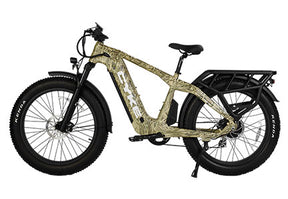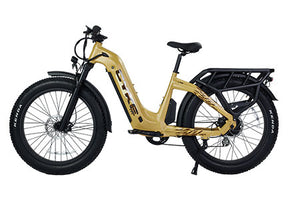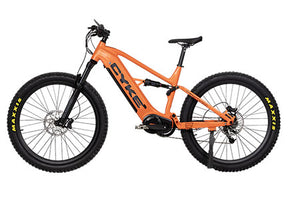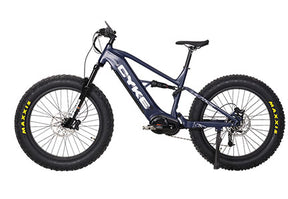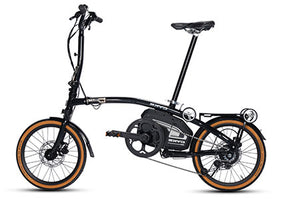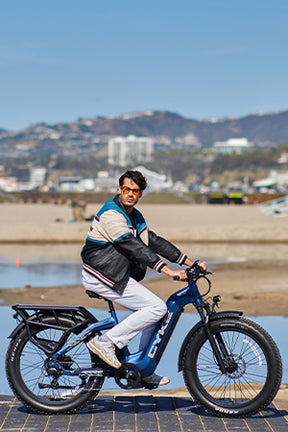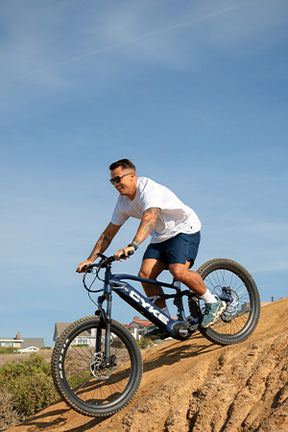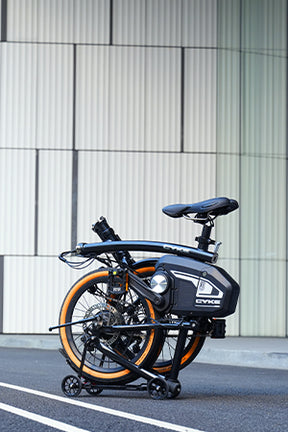Featured in this posts
10 Common Misconceptions About Electric Bikes
If you are interested in a way to stay healthy and be kinder to the environment while traveling for errands, work, and getting together with friends and family, you have likely heard about long-range electric bikes and their growing popularity.
An e-bike, as the name implies, is a bicycle that can run on electricity. If an e-bike has piqued your interest, but you have heard about some negatives from others or social media, we are here to set the record straight about some common misconceptions.

Misconception 1: "E-bikes are equal to electric motorcycles."
This is a common misconception, but the two have one significant difference: pedals! An electric motorcycle does not have pedals that a rider can use. This is a big advantage of the e-bike. Pedals allow you to use the e-bike like a regular bicycle but with less effort. Because they have something called pedal assist.
Pedal assist uses a sensor that talks to the e-bike motor and allows you to reach the desired speed based on your settings. Two types of sensors, cadence and torque, tell the bike's PAS (pedal assist system) when it should engage the motor and propel the e-bike forward.
Misconception 2: "Riding an e-bike doesn't provide any exercise."
The thought that you can't get exercise on an electric bike is a total myth! Studies show that e-bike riders get more exercise than their counterparts on traditional bicycles. The study, published in the International Journal of Behavioral Nutrition and Physical Activity, analyzed data from 10 studies conducted in Europe and North America with 1,415 participants. It found that because of the assistance provided by the motor, cycling becomes easier, therefore, e-bike riders can ride longer and farther than traditional bike riders, resulting in more physical activity and more exercise duration.
The health benefits of regular cycling are well-known and include:
- Reducing anxiety and stress levels
- Increasing cardiovascular fitness, muscle strength, and flexibility
- Preventing and managing disease
- Improving posture and coordination
So, on the contrary, all those benefits should make you want to jump on an e-bike right now!
Misconception 3: "E-bikes are too expensive."
Yes, an electric bike is more expensive than a standard bicycle, but it is an investment that will last for years. Although more expensive upfront, they pay for themselves in savings on gas, car maintenance, Uber fares, and other costs that add up for car travel. For your comparison, in 2022, the average cost of owning a vehicle with all costs combined was $894 per month!
There are also several price ranges for e-bikes, typically from $1000-$8000. This means you can start your e-bike journey at a lower price point if you have a limited budget in the beginning. Then upgrade your e-riding journey after becoming addicted to e-bikes to enjoy all the benefits.
Misconception 4: "E-bikes are dangerous."
It is a common misconception that electric bikes and their riders are more dangerous and cause more accidents on the road. Data from the National Highway Traffic Safety Administration shows that pedestrians faced with car traffic have nearly eight times the fatality rates of bikers.
E-bikes are smaller in size which makes them easier to maneuver than automobiles. And due to the speed limits of e-bikes, the risk of serious injury in the event of an accident has been reduced. Although data on e-bikes is still being gathered, they seem safer for getting to and from destinations.
Misconception 5: "E-bikes are only for lazy people."
As we stated above in misconception number 2, this is entirely false! E-bike users are more active than regular bicycle riders. The reported physical activity levels for e-bikers averaged 4,463 MET minutes/week, compared to 4,085 MET minutes/week for regular cyclists. You can choose from folding e-bikes to off-road e-bikes, for each of them could allow you to get moving on different terrains.
Misconception 6: "E-bikes require a special license."
Different states and cities have their own age restrictions, licensing, or registration for electric bikes. Therefore, always check before you ride somewhere new, as local laws can differ, and e-bikes are often excluded from certain trails, sidewalks, and bike paths in some states.
Most cities post their rules online and on signs outside parks, trails, and streets. You can find full state-by-state guidelines here.
Misconception 7: "E-bikes have a limited range."
An e-bike range will primarily be affected by its battery, and many long-range electric bikes exist. On average, an electric bike can take you from 20-100 miles on a single charge. Some factors that can affect this include:
- Average riding speed
- Motor Power
- Weight of load
- Battery size and type
- Pedal capacity and fitness of the rider
If you are using your e-bike on short commutes to and from work or out for a bit at a local park, you are sure to have plenty of range. E-Bikes from electric bike company CYKE all have a 960Wh LG Battery which allows you to reach a max range of 80 miles, assuring you an extended and joyful adventure without the worry of running out of energy
Misconception 8: "E-bikes are slow and can't keep up with traffic."
E-bikes are faster than you think and can help lessen traffic congestion. Class 3 e-bikes can reach 28 mph when pedaled. This makes them great for riding in urban areas, where you can easily keep up with traffic.
On the other hand, using an e-bike as your mode of transportation can be quicker and easier than a car and allow you to bypass the hassle of gridlock.
Misconception 9: "E-bikes are not environmentally friendly."
E-bikes are exceptionally environmentally friendly. They produce zero emissions, can rely on 100% renewable energy, and don't pollute the air. E-bikes also do not contribute to air quality issues in urban areas due to low carbon emissions.
When engaging in outdoor activities, e-bikes don't affect the pristine air in parks, trails, and other undisturbed natural locations. This is something the local wildlife will appreciate!
Misconception 10: "E-bikes are not reliable."
E–bike has been a reliable mode of transportation for commuting and pleasure for about ten years. The battery typically lasts 3-5 years before the charge capacity declines, and the motor will last approximately 10,000 miles, varying by brand and maintenance.
Almost all e-bikes will come with a warranty, and it is crucial to learn about that before you purchase. High-quality ebikes like those from CYKE come with a 5-year limited warranty that covers manufacturing defects during the average lifespan when you use your e-bike.
If you are ready for a long-range electric bike after reading all these busted myths, check out CYKE for electric bikes that can do it all, from modern commuting to outdoor sports and adventure. With a focus on product quality and excellent customer experience, you will find an e-bike that is high-quality, reliable, and enjoyable.
